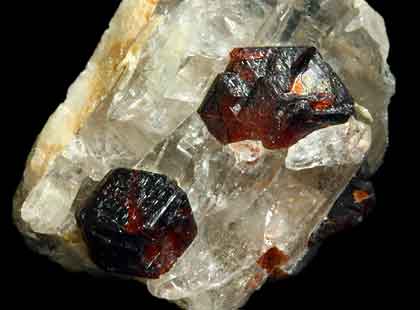Birthstones by the Month
The January Birthstone is Garnet
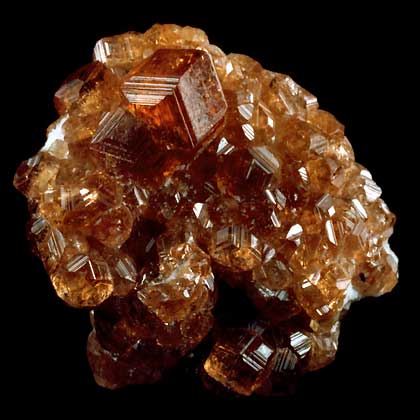
Garnet from the Jeffery Mine
Garnet. Jeffery Mine in Quebec Canada. A Bureau of Mines mineral specimen. [5]
Garnet facts
The January birthstone is Garnet. It naturally occurs in many different colors and shapes. Garnet gemstones are a family of crystals with similar chemical make-up. The natural variety of color and shape can be a great inspiration for jewelry makers and artisans. There are many beautiful pieces of Garnet jewelry on the market today.
The characteristics of Garnet
The January birthstone can be found in shades of red, orange, yellow, green, blue, purple, brown, black, pink and colorless. The rarest color of garnet is blue. Red is the most common. Some varieties of Garnet can absorb the yellow component of some light sources and can change color depending on the quality of the light. Because of this it is often misidentified as Alexandrite.
Cut and Clarity of the January birthstone
Garnets with inclusions are priced much lower than very clear Garnets. Darker shades of Garnet are usually less expensive than brighter shades. A Garnet with poor color and clarity can’t gain clarity or color from a good cut. A Stone that is already great will always look better with a good cut.
The value of Garnet
You can find sizes under five carats with relative ease. As the size goes up the price per carat goes up too. This is because it’s more difficult to find larger stone of good quality. It’s rare to find good quality garnet gemstones larger than 10 carats.
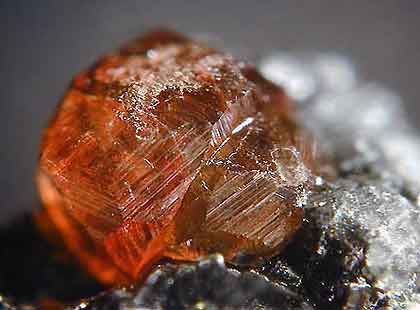
Almandine
Almandine occurs abundantly in Sri Lanka. When the color is a violet tint it is often called Syriam garnet. [3]
Is Garnet ever treated?
Garnets are rarely treated. Although heat treatment is sometimes used.
Types of Garnets
Garnets are gemstones from a family of crystals with structural similarities but have different chemical composition.
Almandine
Almandine, the most commons of the garnets; is an iron-aluminum garnet with the formula Fe3Al2(SiO4)3. These are deep red translucent stones and are often used a gemstones.
Pyrope
Pyrope, can be deep red to black and is contains magnesium aluminum silicate with the formula Mg3Al2(SiO4)3.
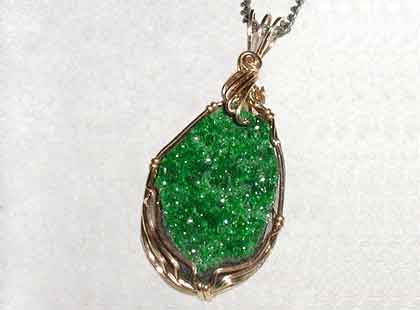
Uvarovite Pendant.
Uvarovite is one of the rarest in the group of garnets. It's the only type of garnet that is consistently green. [4]
Spessartine
Spessartine or spessartite is manganese aluminium garnet, Mn2+3Al2(SiO4)3. These can vary from orange-yellow (found in Madagascar) to violet-red (found in Colorado).
Andradite
Andradite is a calcium-iron garnet, Ca3Fe2Si3O12. These garnets can be red, brown, green, black and yellow.
Tsavorite
Tsavorite or tsavolite is a variety of the garnet group species grossular, a calcium-aluminium garnet with the formula Ca3Al2Si3O12.
Grossular
Grossular is a calcium-aluminium garnet with the formula Ca3Al2(SiO4)3. These tend to be red, cinnamon brown, to yellow.
Uvarovite
Uvarovite is a calcium chromium garnet with the formula Ca3Cr2SiO4)3. It is a rare form of the January Birthstone. Usually bright green in color.
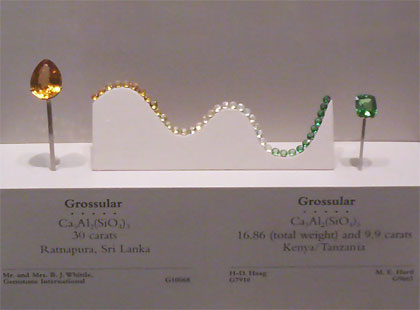
Grossular Shades
Garnet Grossular has multiple shades. This curve shows some of the many hues that can be found. The green gem at right is a type of grossular known as tsavorite. [1]
More about the January birthstone
Garnet is the state mineral of Connecticut and the state gemstone of New York.
Garnet in the form of Star Garnet is the state gemstone of Idaho.
Yttrium aluminum garnet (YAG, Y3Al5O12 ) is a synthetic crystalline material of the garnet group. It is used in some types of solid state lasers.
The American Gem Society's January birthstone page has more information to help you buy from knowledgeable and skilled jewelers and to help you make the most informed buying decision.
Image Attribution
- By Alkivar at en.wikipedia [Public domain], from Wikimedia Commons
- By Elade53 (Own work) [CC BY-SA 3.0], via Wikimedia Commons
- By WesternDevil (ltWiki) [GFDL or CC-BY-SA-3.0], via Wikimedia Commons
- By User Arpingstone on en.wikipedia [Public domain], via Wikimedia Commons
- See page for author [Public domain], via Wikimedia Commons
